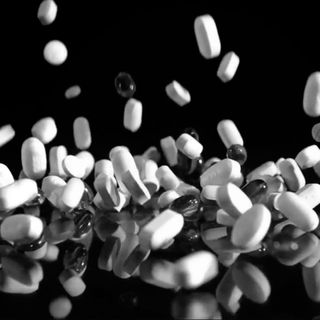
Untrending: There Is No Scientific Evidence Steaming Your Vagina Cleanses It
Vaginal steaming does not improve fertility either, but it might leave you with second-degree burns.

In Untrending, we side-eye the latest fads so we know what we’re getting ourselves into — and what (if anything) we’re getting out of them.
If I see one more woman on Instagram sitting on what essentially looks like a kids’ port-a-potty, giving herself a ‘yoni steam,’ I might scream. Ever since actress Gwyneth Paltrow reviewed a California spa in an article for Goop in 2015 and described her vaginal steaming experience, the trend has spread like a Ponzi steam (sorry, not sorry). So, for once and for all, let’s talk about the science (or, more accurately, the lack of it) behind the so-called benefits of vaginal steaming and leave this apparently ancient ‘tradition’ behind us.
What is vaginal steaming?
Vaginal steaming, V-steaming, or yoni steaming, is a so-called alternative health treatment in which a woman sits over steaming hot water infused with herbs such as mugwort, basil, rosemary, chamomile, and/or oregano, and undergoes what is colloquially also dubbed a ‘facial for your vagina.’ An average steam session can last anywhere between 20 to 60 minutes.
Advocates claim the steam cleanses the vagina, uterus and the entire reproductive tract, regulates menstruation, eases period cramps, reduces bloating and heavy bleeding, and improves fertility and sexual pleasure (especially for a male partner). The tall claims don’t end here: vaginal steaming is touted to apparently relieve stress, hemorrhoids, headaches, fatigue, and digestive issues. It is also believed to reduce vaginal prolapse (a condition in which the muscles that support a woman’s organs in the pelvic area weaken, causing the organs to sink down into the vagina), cure infertility and hormone imbalances, and promote healing after childbirth. How? These apparently are the effects of the herbs in the water, which supposedly penetrate vaginal tissue through the steam, or at least that’s what’s peddled to the masses.
It’s a miracle! A day at a spa or even just a basin with hot water and rose petals at home can do all of this? Erm, no.
Related on The Swaddle:
For Women, Beauty Is Often Conflated With Hygiene
Vaginal steaming is anatomically faulty.
There is no scientific evidence (since there have been no research studies) that proves vaginal steaming does any of the things it claims to do.
A report in The Guardian also debunked the claim that heat, steam or mugwort — the herb Paltrow absorbed vaginally — had any benefit; the report additionally noted vaginal steaming could be harmful. Even if we are to consider that, in traditional Chinese medicine, mugwort is often used to treat a range of reproductive system problems, the science of its effectiveness remains inconclusive and contradictory, according to a 2010 systematic review.
OB-GYN Dr. Jen Gunter has since then explained in a viral post on her website how the mechanism of vaginal steaming makes no anatomical sense. It just isn’t possible forsteam-borne herbs to reach the uterus, having to pass through a very narrow cervix at the end of the tubular vaginal canal, which is covered by the protective labia.
Sure, the vaginal membrane is absorbent; it can absorb medication, but only with “the right medication and dose and the right delivery vehicle,” writes Dr. Gunter. “Steam does not meet this criterion. Aerosolizing a medication is effective for lungs, but the vulva, vagina, and uterus are all quite deficient when it comes to inhalation and gas exchange mechanisms with the bloodstream.” In other words, because the vagina can’t inhale things, there is little-to-no chance steam, herbal or otherwise, can penetrate into the reproductive system through it.
And even if the herbal steam somehow entered the uterus, it would have to regulate hormones somehow … but how? The primary hormones that regulate a woman’s cycle and vaginal health — estrogen and progesterone — are created in the ovary, regulated by the brain, and transmitted via the blood.
Vaginal steaming can be straight-up dangerous.
“Your vagina isn’t meant to be steam-cleaned. An overheated vagina may provide the perfect environment for bacteria that cause yeast infections and other vaginal infections to thrive,” according to a primer on Healthline.
Dr. Gunter calls the vagina (and uterus and vulva for that matter) a “self-cleaning oven.”
“We know that douching is harmful, heck, even seminal fluid can be harmful (exposure to multiple partners without condoms is a major risk factor for the imbalance of the vaginal ecosystem). The upper and lower reproductive tracts have very intricate mechanisms for regulating local health and they are very easy to mess with. It’s a delicate garden, if you will. So one needs to be thoughtful, nay conscious, about what one uses in said garden,” she writes in her blog post.
Related on The Swaddle:
Vaginal Discharge Is a Sign of a Healthy Vagina
Basically, the vagina doesn’t need cleaning. It was built to clean and manage itself.
Subtle changes in the pH of the ecosystem can lead to odor and discomfort; for the same reason physicians are against ‘feminine washes,’ they advise against vaginal steaming. “We don’t know the effect of steam on the lower reproductive tract, but the lactobacilli strains that keep vaginas healthy are very finicky about their environment and raising the temperature with steam and whatever infrared nonsense Paltrow means is likely, not beneficial and is potentially harmful,” writes Dr. Gunter. Additionally, herbs are potent allergens and can cause reactions on the surface of the vaginal skin, which is, frankly, the worst place to get an allergy.
I’ve been saving the best reason to not steam your vagina, for the last. Are you ready?
Don’t do it because you might burn your vaginal skin. It is delicate and sensitive; a plume of hot steam can lead to scalding, as in the recent case of a woman who ended up with second-degree burns to the lining of her cervix because of vaginal steaming.
Ouch, if there ever was one.
The concept of vaginal steaming rests on patriarchal norms.
This need to clean the vagina, the womb, the yoni — where is it arising from? A look at the reasons why women mostly do it throws some light on the answer to that question.
A 2011 study by the World Health Organization on vaginal practices showed the underlying reasons behind vaginal steaming stemmed from a cultural discourse that sets the default for the female body as dirty and deficient. A more recent 2017 survey, published in Culture, Health & Sexuality, analyzed the socio-cultural assumptions within the vaginal steaming discourse, and found that “the sexual and reproductive enhancement focus [as a selling point for vaginal steaming] mirrors the two modes through which Western societies have traditionally valued women: sexual availability for men (within marriage) and childbearing.”
The general theme around the vaginal steaming trend seems to be centered around the self-assured, self-improving, neo-liberal woman, who lives in a post-feminist world and, completely out of her free will, chooses to optimize her vagina. She seeks out the ‘reawakening’ of her ‘inner goddess’ in another never-ending quest to reach her perfect, ideal, Devi self.
Please. Women are fine, enough and clean, just as they are.
At best, a vaginal steam’s moist heat may increase the blood flow to the area, and help you relax (like a heating pad does), but that can be achieved via a sitz bath or soaking in a warm tub, sans the danger of burning your labia. Or as Dr. Gunter suggests, “If you want to relax your vagina, have an orgasm,” will you?
Pallavi Prasad is The Swaddle's Features Editor. When she isn't fighting for gender justice and being righteous, you can find her dabbling in street and sports photography, reading philosophy, drowning in green tea, and procrastinating on doing the dishes.
Related


Lack of Sleep From Social Media Affects Mental Health More Than the Actual Apps Do
